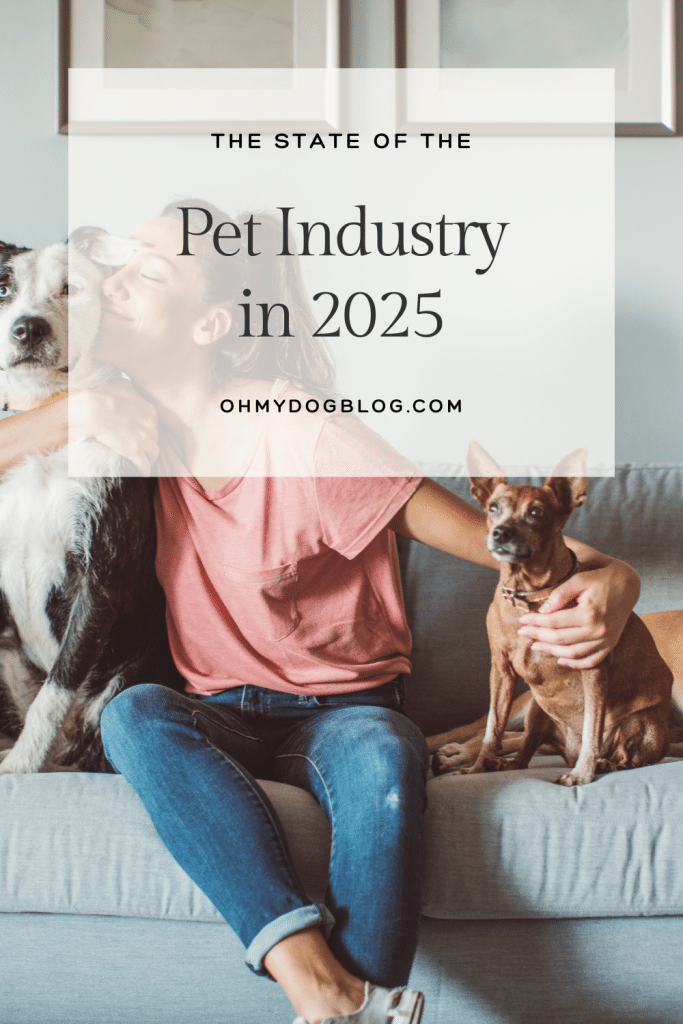Table of Contents

There’s a lot we all disagree on these days, but I think the one thing everyone can agree on is this: The economy is weird right now.
I don’t know anyone who isn’t stressed about the rising cost of food or concerned about the disruptions to manufacturing. Or the million other new things to be worried about each day.
But, as pet lovers, we’re operating in an interesting economic space with two diametrically opposed impacts, which I want to explore in this post.
You’re not a pet product manufacturer or a pet retailer. You don’t run a pet-specific business or ship pet goods.
You might be thinking that this discussion doesn’t apply to you.
Well, as a pet owner and as someone who needs to buy pet supplies to keep your animals healthy and happy, this is incredibly important. So, I hope you read on.
A couple weeks ago, I attended Global Pet Expo, which is the largest pet industry trade show in the world. For the few days leading up to it, I attended and spoke at The Pet Summit, a conference that coincides with GPE.
At both events, a single theme emerged: Everyone is uncertain.
Uncertain isn’t a comfy place to be, and it certainly isn’t a secure place from which to operate a business.
But, it’s where we are right now, so we need to explore what this uncertainty means because the reality is, in our industry, an uncertain economy impacts the welfare of our animals.
Will the pet industry continue to grow?
One of the lunch keynotes I attended was given by a market research organization that studies and quantifies the impact of pet ownership. I was thrilled with much of the data they reported:
Research from the Human Animal Bond Research Institute (HABRI) proves the tremendous benefit to human life by having a pet in the home.
Pet ownership saves healthcare more than $22 billion annually. (Read this study!)
Also, the answer to the headline question is YES the pet industry is continuing to grow. Estimates suggest the industry will hit $157 billion in 2025 and $192 billion by 2030.
And, yet, the report continued that the cost of owning a pet is becoming increasingly out of reach, with many pet owners struggling to provide the basics and to afford veterinary care.
I was disappointed with the premise they presented as a solution: increase pet ownership!
Wait. Huh?
That’s right. The idea, according to this research organization, is to increase pet ownership. How does that help… anyone?
Well, he said, more pet ownership will increase sales! And therefore the pet industry will grow! More pets = more spending = more earnings!
WAIT. HUH?
I found it disheartening that the proposal to grow the pet industry during a time of–let’s face it–recession was to add more pets to the mix. While I do agree wholeheartedly that pet ownership needs to be easier and more affordable than it is, it’s unreasonable to think that a single focus on scaling pet ownership won’t impact quality of life, shelter overpopulation, and so on. Yes, make pet ownership easier and more affordable. No, don’t bank an entire industry’s growth on it. These are living, breathing, feeling beings. “Getting more” isn’t the answer.
I would love for everyone to have a pet IF everyone wants a pet. Of course, not everyone does want a pet. And lots of people who do want a pet know it’s not the right time to have a pet. So why on earth would increasing pet ownership be the solution to this current economic crisis we’re in?
(It’s not, btw. It’s not the solution.)
What about pet ownership, though? Are people not getting pets anymore?
So, that’s the thing. People OF COURSE are still acquiring pets.
Currently, we’re seeing increases in pet ownership among Gen Z and Millennial men, which is interesting, and the rise is being seen in cat ownership! However, most people still have dogs (51%) compared to cats (37%).
Maybe the increase in cat ownership is because cats are generally more affordable than dogs. Maybe it’s because folks in younger generations are struggling to find good jobs and housing they can afford so are choosing smaller animals for smaller or shared spaces. Maybe it’s because cats are super awesome. It’s probably a mix of the above and more.
But what happens when the cost of caring for our pets because nearly impossible?
Here’s where that diametric opposition I mentioned comes into play.
Everything is already or is becoming less affordable.
We are, by all reports, on the precipice of a recession if not already in one.
Analysts predict that the economy will continue to worsen, and that means we all have to tighten our belts.
But here’s the thing: Pet owners will cancel Netflix. Pet owners will close their Prime account or cook at home or pick up a side job before they will sacrifice their pet’s well being.
Because you might like watching Netflix or ordering tacos, but you love your pet.
Nonstop growth shouldn’t be the goal
So, I know. This is a wildly unpopular take. Capitalists want the market to always be growing.
But that isn’t possible, not without causing harm.
Getting people to acquire more animals isn’t the answer to getting them to spend more money. Spending more money isn’t the answer, anyway.
We can’t continue to force unsustainable growth in an industry that relies on the health and well-being of live animals.
Pets are hopeful, especially in these bleak times
When things are falling apart, our animals can help us keep it together.
I hope you and your family are hanging in there and preparing for the turbulent times ahead.
I didn’t even touch on tariffs in this post because that mess seems to shift and change daily, but the panel I attended on the issue said the same three things everyone is saying: Companies need to source materials and/or manufacturing elsewhere, or they need to assume the tariff costs themselves, or–most likely–they need to pass on the tariff increase to their consumers. Pet owners, prepare to spend more on the basics and maybe skip for a while the luxuries. (No Easter collars this year!)
I’m also working on a post right now that is going to take me a good long while, but it’s apparent that these diversity, equity, and inclusion cutbacks are having a direct impact on euthanasia rates. It’s bad, you guys. I’m not going to post until I have all the data sourced, cited, and backed up, but stay tuned…
My conclusion on the state of the pet industry in 2025?
Things will be challenging for a while. You have a good heart. Take care of your pets. Love them well.
If you need to make budget cuts, do so without guilt.
We’re all in this together. (Or, at least, we should be…)
If you enjoyed this post, you’ll love my forthcoming book, FOR THE LOVE OF DOG, from Regalo Press. It’s chock full of the latest research in canine cognition combined with stories of my dogs to bring the data to life. Pre-order now!


